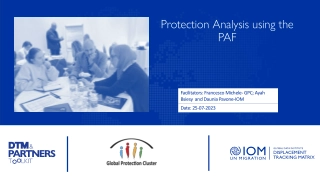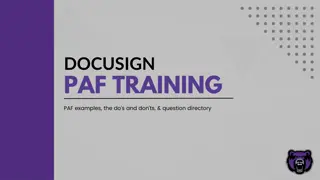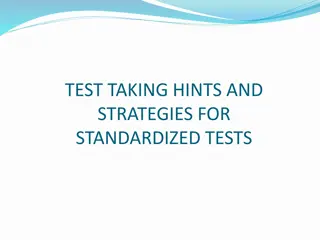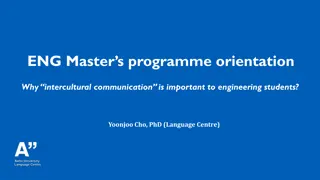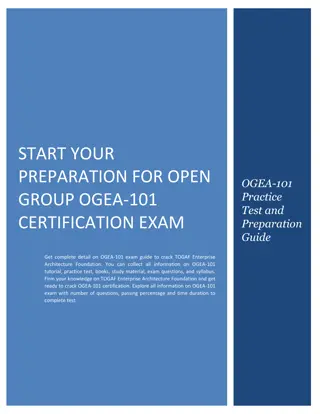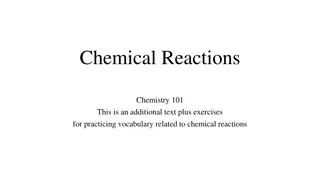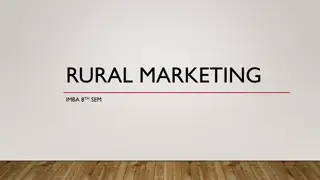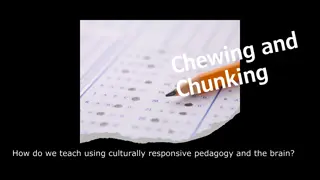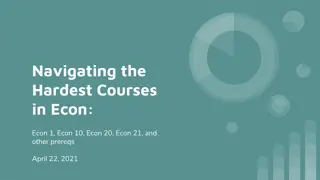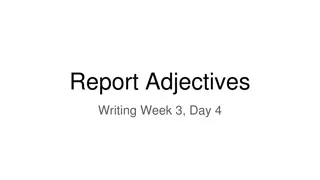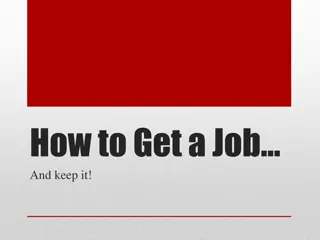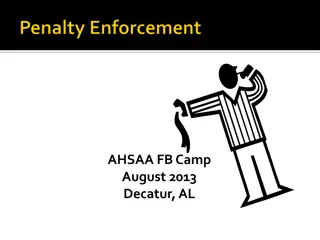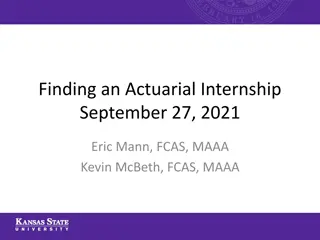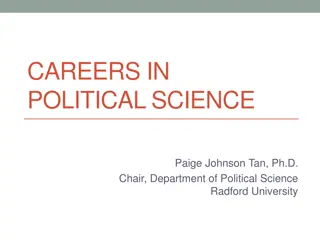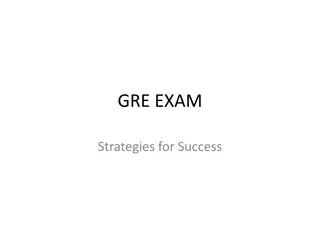Effective Strategies for Succeeding in PAF.101
Explore the key insights from PAF.101 Module 2, Lecture 8 focusing on seizing opportunities, homework responsibilities, database citation, competition outcomes, alumni experiences, and the importance of attention to detail in the real world. Learn from valuable quotes and practical examples shared in the material to enhance your academic and professional journey. Stay informed, engaged, and proactive in your learning approach to maximize your potential in PAF.101.
Download Presentation

Please find below an Image/Link to download the presentation.
The content on the website is provided AS IS for your information and personal use only. It may not be sold, licensed, or shared on other websites without obtaining consent from the author. Download presentation by click this link. If you encounter any issues during the download, it is possible that the publisher has removed the file from their server.
E N D
Presentation Transcript
PAF 101 Module 2, Lecture 8 You miss 100 percent of the shots you don t take. ~Wayne Gretzky ~Michael Scott
Class Agenda Class Agenda Announcements Competition Debriefing Attendance Policy Reminder Assignment for Next Class
Class Homework Reminder Class Homework Reminder If absent, you are still responsible for homework. Check the previous lecture slides online. If you miss class Monday, and homework is due Wednesday, you must bring it in Wednesday or you will receive a five point penalty.
How to Cite a Database (Table How to Cite a Database (Table) in the Reference Page Reference Page ) in the Table s source. (Year table was published). Title of table. [Years table looks at]. (Page number, table number if applicable). Where it was retrieved from. EXAMPLE: Pew Research Center s Internet & American Life Project. (2013). Employment status: % of those who have diabetes versus those who do not, by employment status. [August 7-September 6, 2012]. (Page no. 22). Retrieved from ProQuest Statistical Insight database.
Competition Points Group # Total 17 19 14 17 16 12 Winners 2 10 5 10 8 10 13 10 18 10 4 9 6 8 7 8 10 8 15 8 9 7 12 7 1 6 Losers As of 02/20/2017 3 6 11 6
Competition Workshop Points Group 14 receives 5 points Everyone else received 3 points
Alumni Quote When I was a TA for PAF 101, students complained about how anal we and you were about spelling, grammar, font and all those fun formatting rules that everyone loses points for on those modules. And I remember students saying it wasn t relevant to the real world and that only in academia did such BS exist. Well, thank God for such anal retentiveness, because these government contracts and guidelines are so specific it would blow the PAF requirements to shame! Attention to detail is the first rule for getting your Attention to detail is the first rule for getting your foot in the door of the real world! foot in the door of the real world! ~Laurie Schrall, Senior Consultant at consulting firm, BearingPoint
BAD THINGS HAPPEN WHEN YOU BAD THINGS HAPPEN WHEN YOU DON T DON T PAY ATTENTION TO DETAIL PAY ATTENTION TO DETAIL HEY, SEXY. WANNA ENROLL? HEY, SEXY. WANNA ENROLL? Admissions forms that Seton Hall University mailed to tens of thousands of prospective students abroad contained a misprinted telephone number that instead connected callers to a phone-sex line, the Newark, N.J., Star-Ledger reported. A recording instructed callers to dial another number to talk to "hot, horny girls" for 99 cents to $2.99 a minute (Chronicle of Higher Education, 2/15/06).
Competition Debriefing Competition Debriefing Step 1: Look at slide with mistakes Step 2: 30 seconds to identify mistakes with your group Step 3: Groups will be called on randomly and 1 person will answer Step 4: Coplin will give points if he feels like it
Module 2 Debriefing Topic: The Chancellor of Syracuse University, Kent Syverud, asked for the design of a survey to assess what undergraduates think of his leadership on campus.
For Any Module For Any Module NO SU POLICIES!!!!
Exercise 4.1 A (Kent Syverud) Gathering Information for and Determining the Purpose of a Survey Quote the definition of the term target population from the Maxwell Manual. Place definition here: The target population is the group of individuals who answer the survey.
Exercise 4.1 A (Kent Syverud) Gathering Information for and Determining the Purpose of a Survey Quote the definition of the term target population from the Maxwell Manual. Place definition here: The target population is the group of individuals who answer the survey. Problem 2: The quote is missing an internal citation. (Coplin, 2007, p. 38) Problem 1: The definition given is for sample not target population.
Exercise 4.1 B Gathering Information for and Determining the Purpose of a Survey (Kent Syverud) Name the Player, their organization and title here: Chancellor Kent Syverud, Syracuse University, Chancellor Briefly describe the purpose of the survey you will be designing here: Asking students about the Chancellor
Exercise 4.1 B Gathering Information for and Determining the Purpose of a Survey (Kent Syverud) Name the Player, their organization and title here: Chancellor Kent Syverud, Syracuse University, Chancellor Briefly describe the purpose of the survey you will be designing here: Asking students about the Chancellor Problem 2: Description of survey is poor. Should talk about the students view on the Chancellor s leadership in undergraduate education. Problem 1: Do not include Chancellor twice.
Exercise 4.1 B (Cont.) Gathering Information for and Determining the Purpose of a Survey Identify the target population you will sample for your survey. Write a specific description of your target population including its geographic location and approximate size: Students attending class on campus
Exercise 4.1 B (Cont.) Gathering Information for and Determining the Purpose of a Survey Identify the target population you will sample for your survey. Write a specific description of your target population including its geographic location and approximate size: Students attending class on campus Problem 1: Missing geographic location Problem 3: Not specific enough. Full-time? Undergraduate? Problem 2: Missing approximate size
Exercise 4.1B (Cont.) Gathering Information for and Determining the Purpose of a Survey Write a piece of factual information that could be gathered through your survey here: The percentage of students who are satisfied and unsatisfied with the current undergraduate education system Write a piece of attitudinal information that could be gathered through your survey here: Whether or not students think the Chancellor is a good leader
Exercise 4.1B (Cont.) (Kent Syverud) Gathering Information for and Determining the Purpose of a Survey Write a piece of factual information that could be gathered through your survey here: The percentage of students who are satisfied and unsatisfied with the current undergraduate education system Write a piece of attitudinal information that could be gathered through your survey here: Whether or not students think the Chancellor is a good leader Bullet 2: Correct Problem 1: The factual information is actually attitudinal. Change to: age, gender, graduation year
Exercise 4.1B (Cont.) (Kent Syverud) Gathering Information for and Determining the Purpose of a Survey Describe specific policies the player might develop from the information gathered in your survey here: Chancellor Syverud will have more open office hours and will provide raises for faculty.
Exercise 4.1B (Cont.) (Kent Syverud) Gathering Information for and Determining the Purpose of a Survey Describe specific policies the player might develop from the information gathered in your survey here: Chancellor Syverud will have more open office hours and will provide raises for faculty. Problem 2: The second policy is not relevant to the topic.
Exercise 4.2 A (Kent Syverud) Choosing a Sample and Method of Contact Indicate and discuss which of the three methods of contact from the Maxwell Manual you will use to contact your sample. State the method using terms in the Maxwell Manual here: Email and call people Justify why you have chosen to use this method using information from the Maxwell Manual here: This way, we can try and reach every single person either with phone or email.
Exercise 4.2 A Choosing a Sample and Method of Contact Indicate and discuss which of the three methods of contact from the Maxwell Manual you will use to contact your sample. State the method using terms in the Maxwell Manual here: E-mail and call people Justify why you have chosen to use this method using information from the Maxwell Manual here: This way, we can try and reach every single person either with phone or email. Problem 1: Should be only one method of contact. Also, use specific language from the Maxwell Manual. (Ex: call people should be telephone ) (Kent Syverud) Problem 2: Weak justification. Should include a rationale like: This method has a high response rate according to the Maxwell Manual. This range should be satisfactory because the response rate for telephone is 40-75% (Coplin, 2007, p.49).
Exercise 4.2 B (Kent Syverud) Choosing a Sample and Method of Contact Identify one variable you will use to assess the degree to which your sample accurately reflects your target population. Identify the variable here: Attitudes toward the Chancellor
Exercise 4.2 B (Kent Syverud) Choosing a Sample and Method of Contact Identify one variable you will use to assess the degree to which your sample accurately reflects your target population. Identify the variable here: Attitudes toward the Chancellor Problem 1: Not an appropriate variable; should choose gender, age, class year, race, or other traceable characteristic.
Exercise 4.2 B (Kent Syverud) Choosing a Sample and Method of Contact Explain why the variable you chose matters, and why it is important that the distribution of your particular variable should be similar to the target population: The way people will answer the survey will be determined by their views toward the chancellor.
Exercise 4.2 B (Kent Syverud) Choosing a Sample and Method of Contact Explain why the variable you chose matters, and why it is important that the distribution of your particular variable should be similar to the target population: A respondent s age could affect their attitude toward the Chancellor. Problem 1: Incorrect justification. The distribution of age in population should be similar to that of the sample to ensure that the sample accurately represents the true population of SU students.
Exercise 4.3 A (Kent Syverud) How Would You Get the Sample Clearly and concisely describe the exact procedures you will use to select the sample and contact the respondents. Be detailed and list each step needed to select the sample. Be realistic. List the steps you will follow here: 1. Call students in a random order. 2. Ask them the questions. 3. Record the answers.
Exercise 4.3 A How Would You Get the Sample Clearly and concisely describe the exact procedures you will use to select the sample and contact the respondents. Be detailed and list each step needed to select the sample. Be realistic. List the steps you will follow here: 1. Call students in a random order. 2. Ask them the questions. 3. Record the answers. (Kent Syverud) Problem: Steps are incomplete. Where do they get the names? Need a list. Need to describe how the process would be random. Restate the specific target population
Exercise 4.3 B (Kent Syverud) Determining Sample Size Complete the following steps to determine your sample size. Restate your target population (from 4.1B) and its size here: SU undergrads, 14,000 students Indicate the size of the sample you plan to analyze here: 14,000 Indicate the approximate percentage this represents of the target population here: 45%
Exercise 4.3 B (Kent Syverud) Determining Sample Size Complete the following steps to determine your sample size. Restate your target population (from 4.1B) and its size here: SU full-time undergrads, 14,000 students Indicate the size of the sample you plan to analyze here: 14,000 Indicate the approximate percentage this represents of the target population here: 45% Problem 1: The sample can t be the entire population. Use the Maxwell Manual to determine the appropriate sample size. The correct sample size is 2,000 Problem 2: Percent is incorrect. 2,000/14,000 x 100 = 14%
Exercise 4.3 C Determining Sample Size Complete the following steps to determine your response rate and required number of contacts. Estimate the exact response rate you expect for your survey here: 1,750 people Justify the rate you chose here: According to the Maxwell Manual, phone calls will get a 40% - 75% response rate (Coplin, 2007, p. 49). Write down how many people you will have to contact in order to obtain your desired number of responses here: 2000 Using the formula from the text, show the calculations that you used to find how many people you will have to contact here: Desired sample = # of contacts Expected response rate 1.15 2000 = 1750
Exercise 4.3 C Problem 1: Response rate should be a percent, not a raw number. Determining Sample Size Complete the following steps to determine your response rate and required number of contacts. Estimate the exact response rate you expect for your survey here: 1,750 people Justify the rate you chose here: According to the Maxwell Manual, phone calls will get a 40% - 75% response rate (Coplin, 2007, p. 49). Write down how many people you will have to contact in order to obtain your desired number of responses here: 2000 Using the formula from the text, show the calculations that you used to find how many people you will have to contact here: Desired sample = # of contacts Expected response rate 1.15 Problems 3: This is assuming that the response rate will be 100%. Your sampling frame must larger than your sample. The correct answer is 5,000 2000 = 1750 Problems 4: The expected response rate should be .40 instead of 1.15. If you use this calculation the answer will be 5,000. Problem 2: Not an adequate justification; must state why that rate was chosen and need to pick ONE rate, not a range. Ex: the correct rate is 40%
Exercise 4.4 (Kent Syverud) Creating the Questions Provide examples of two closed-choice questions for your survey. All response categories must be shown. Follow the format in the Maxwell Manual. Write the question that will gather factual information here: Do you think Kent Syverud s blog posts and emails are effective? Yes No Don t Know/Not Sure Write the question that will gather attitudinal information here: Do you believe Kent Syverud is an approachable person outside of academics? Yes No
Exercise 4.4 (Kent Syverud) Creating the Questions Provide examples of two closed-choice questions for your survey. All response categories must be shown. Follow the format in the Maxwell Manual. Write the question that will gather factual information here: Do you think Kent Syverud s blog posts and emails are effective? Yes No Don t Know/Not Sure Write the question that will gather attitudinal information here: Do you believe Kent Syverud is an approachable person outside of academics? Yes No Problem 1: This question is attitudinal because it asks for an opinion. Problem 2: Should also say Not Sure/Don t Know
Helpful Hints: Know the difference between factual and attitudinal Closed questions should include all choices, including Don t know or N/A Don t overestimate response rate; must justify with Maxwell Manual Descriptions must be specific (mention specific type of policy) Variables: Freshman and Sophomore are not the name of the variable: Class year is.
Joyce Suslovic Syracuse University Alumnus History teacher at Henninger High School in the Syracuse City School District Led the 2 miles too far initiative to provide buses to any student living more than a mile from school.
ALEXANDRA DONEY (16) Class of 2016 Political Science (CAS), Policy Studies (CAS), Citizenship and Civic Engagement (MAX) OCBAACP- (May 2015- December 2016) City Court Arraignments, Data Analysis and Audits, Mentor Program, CAFA Lewis Defenders, PLLC. (December 2016- May 2017) Criminal Trial Preparation, Estates, Real Estate, Probate, Assisting Public Defender alex.doney.94@gmail.com
For For Next Class Next Class Module Two is Due By 12:45 p.m. on Friday, October 7 Friday, October 7 Don t email your TA after 12:45 Don t email your TA after 12:45 PM on Thursday PM on Thursday



